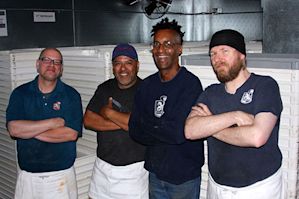100 Years of Dough

How hard could it be? Flour, water, salt, yeast. Just four ingredients. Simple, right?
Not really. Just ask these guys at the Pagliacci commissary. Between the four of them they have over a hundred years of experience. Edgar Bobadilla, General Manager of the Commissary, tops Pagliacci’s overall tenure chart with almost 35 years of experience. Alan Lehman has been with Pagliacci for 30 years, Todd Weyand, Commissary Associate Manager, a little over 20, and Ken Keeling is nearing 15.
Making thousands of dough balls, day in and day out, getting just the right mix of elasticity and resilience, is quite a challenge. Dough is a living, breathing thing that is very sensitive to the outside environment. The temperatures of the water, the flour, and the kitchen all have an impact, as do humidity levels. Any variance will affect the quality of the crust when it's baked. In managing these factors, experience is key.
At 24 stores and growing, managing Pagliacci’s daily dough production has gotten complex. Pagliacci allows the dough to proof for three days, an optimal time to develop flavor and texture. Anticipating dough needs three days out takes a lot of tracking, a little guesswork, and the steady hand of experience.
Another critical element that cannot be overlooked is the dough’s journey from the commissary to stores. If the delivery truck has warm spots, and on these ninety-degree days that can be an issue even with refrigerated delivery trucks, you change the chemistry. And it must be placed in the cooler right away, and get rotated, so the store cooks use the right dough. Ken provides the commissary with valuable eyes on the road. He ensures each store is managing their dough appropriately and that their walk-in temperature is ideal.
Edgar learned the dough-making process from the founders of the company. He says, “We only had three stores then, way less volume. With growth, we’ve had to figure out how to maintain consistency along with improving efficiency.” In those early years, Edgar would make dough in the morning, doing all the kneading by hand, and deliver it in the afternoon—in a green and white Volkswagen van missing first gear. “Slap it into second and get it to go,” he says with a laugh. Now there are three large, highly-insulated refrigerator trucks. “When I started, I wasn’t working in a temperature and humidity controlled kitchen. We learned things the hard way back then. But that experience gave me a lot of knowledge.”
Today’s dough recipe is exactly the same as it was then. Every month Pagliacci runs two new pies, a crew pie and a seasonal special. The commissary orders one of each from every store at the beginning of each run. Each gets tested and graded on appearance, freshness, and taste. “That kind of testing is central to our success,” Todd says.
But even with testing and tracking variables such as water, which runs from about 40 degrees in the winter to 68 degrees in the summer, the unexpected happens. Some years ago some of the dough was rising too fast, “blowing up” in Todd’s words. Todd, Alan, and Edgar worked through all the variables and discovered it was the temperature of the flour. The mill’s new delivery truck was hot, so the flour was warmer, especially the bags on top of the pallets. Now they wait until the flour cools to a stable temperature before they use it. “Every problem you overcome teaches you valuable tricks,” Edgar says.
With a hundred years of experience and counting the crew in the commissary has seen it all and is able and ready to handle whatever comes next.

